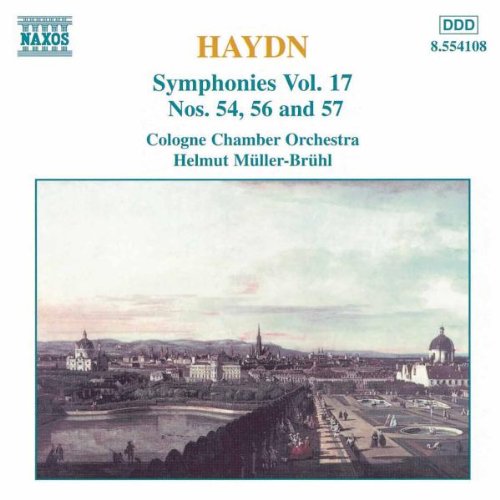Franz Joseph Haydn Album: «Haydn: Symphonies Nos. 54, 56 & 57»

- Customers rating: (4.0 of 5)
- Title:Haydn: Symphonies Nos. 54, 56 & 57
- Release date:1997-08-05
- Type:Audio CD
- Label:Naxos
- UPC:636943410820
- 1Sym No.54 in G: Adagio Maestoso-Presto
- 2Sym No.54 in G: Adagio Assai
- 3Sym No.54 in G: Menuett: Allegretto
- 4Sym No.54 in G: Finale: Presto
- 5Sym No.56 in C: Allegro Di Molto
- 6Sym No.56 in C: Adagio
- 7Sym No.56 in C: Menuet
- 8Sym No.56 in C: Finale: Prestissimo
- 9Sym No.57 in D: Adagio-Allegro
- 10Sym No.57 in D: Adagio
- 11Sym No.57 in D: Menuet: Allegretto
- 12Sym No.57 in D: Prestissimo
Haydn composed his symphonies 54,56, and 57 in 1774. These symphonies are lively, cheerful and graceful. Thus, they differ markedly from the minor-key symphonies, such as the "Lamentation" "Trauer" "La Passione" and others that Haydn composed in the late 1760s. These symphonies are lyrical and make good use of the interplay between strings and winds and of contrasts in dynamics. In addition, each of these works has a lovely slow movement.
Symphony no. 54 in G major opens with a short slow introduction consisting of loud, stern passages contrasting with lyrical and quieter responses. This contrast sets the pattern for the entire work. Thus, the following "presto" opens with a march-like theme in the strings and horn followed by a softer, answering theme in the winds. The second movement, adagio molto, is substantially longer than the opening movement. It opens with a lengthy theme for the muted lower strings. As it progresses, the movement assumes a serious cast in an eloquent passage for the entire ensemble followed by a return of the opening material with solos added for violin. The minuet is a flowing melody for strings with the winds chiming in. The trio consists of a solo for the bassoon in the higher reaches of its register. The finale, marked "presto", is in sonata form and alternates a lively and joyous with a quiet theme for strings. The timpani has a preeminent role in this movement adding rhythm and joy.
The symphony no. 56 in C major is the only one of this set without a slow introduction. The opening movement, "allegro di molto" features again a great deal of timpani together with contrasting themes in the strings. The movement comes to a big close which includes a trumpet fanfare. The highlight of the slow movement, "adagio", is a theme for the solo bassoon which appears immediately after a short introduction for muted strings and continues throughout the movement. Haydn makes great use of this beautiful instrument. The minuet is moderately paced and stately in character with, again, marked use of tympani. The contrasting trio is a light theme predominantly in the winds.
The finale, "prestissimo" is in sonata form and begins with a growling figure for the lower strings answered by the higher strings. This movement makes much use of triplet figures and the timpani again sets the rhythm.
The third symphony on this CD,no. 57 in D major, opens with a slow introduction that is longer and more tentative in character than the introduction for symphony 54. The introduction is followed by a galant allegro with a dashing opening theme and a more lyrical second theme. The lovely adagio, opens with a passage for plucked strings followed by the passage repeated in bowed strings. As the movement progresses, this pattern is repeated and embellished. The bowed melody becomes more embellished and the winds ultimately join in. The movement ends quietly with the plucked passage with which it began. The minuet is quiet and bouncy with an oom-pah-pah accompaniment; but the contrasting trio moves into the minor. The finale, "prestissimo" is in perpetual motion with sections that slow down briefly and with a brushy theme that appears at time under held notes in the winds. There is a brief dip into the minor key, but the movement offers a happy and humorous conclusion to a delightful work.
This CD is part of a compilation of the Haydn symphonies on the budget-priced Naxos label. The performers are the Cologne Chamber Orchestra under the direction of Helmut Muller-Bruhl. The symphonies on this disk are not among Haydn's better-known works. But they contain much to enjoy by those listeners eager to explore the works of this great and still under-appreciated master.
When I first got into classical music, purchasing all 104 symphonies by Haydn seemed like a monumental, if not impossible task. I simply couldn't afford something as grand as the Dorati Complete Haydn Symphonies Boxed Set (though one of these days it will be mine!). With so many choices available for the "Paris" Symphonies up through the "London" Symphonies, I have had a great time purchasing and comparing interpretations by various conductors - Bernstein, Szell, Davis, Beecham, Jochum, Furtwangler, Klemperer, Kempe, Karajan and Ansermet among others. However, if you are looking for Haydn pre-Symphony No. 82, your choices diminish drastically.
While I have generally steered away from Naxos when it comes to the standard repertoire (I just enjoy the "great" conductors and performers of the century too much), the label has never let me down when trying to get recordings of more obscure works. I am now the proud owner of nearly a dozen Haydn Naxos Symphony CDs, including this title, Volume 17 of Symphonies 54, 56 and 57 with Bruhl and the Cologne C.O. While they are different symphonies from the "great" conductor accounts I mentioned above, in terms of overall quality and sound, the performances are completely on par, well at least to my intermediate-level listening ear. At this rate, I may continue backwards with Haydn's Symphonies on Naxos until I reach el numero uno. And another nice thing is that with Naxos that might even be an affordable undertaking.

